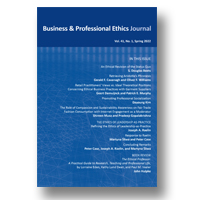|
|
|
1.
|
Business and Professional Ethics Journal:
Volume >
38 >
Issue: 2
Thomas D. Berry, Erica Wagner
The Relationship between Firm Innovation and Corporate Social Responsibility
abstract |
view |
rights & permissions
| cited by
Firm innovation creates an informational asymmetry between the firm and outside stakeholders. Since CSR activities have been shown to reduce asymmetries and risk we surmise that firms use discretionary CSR activities to reduce the asymmetries from innovation. We study an innovation intense industry (technology) and find results that support the hypothesis that firms use CSR to signal long term viability of innovative activities.
|
|
|
|
|
|
|
2.
|
Business and Professional Ethics Journal:
Volume >
38 >
Issue: 2
George Lan
Personal Values and Value Priorities of Undergraduate Business Students
abstract |
view |
rights & permissions
| cited by
The Schwartz Values Survey (SVS), developed by Shalom Schwartz, was used to explore the values and value priorities of undergraduate business students in a mid-sized Canadian university. These business students considered family security as their top individual value and ranked successful, healthy, and enjoying life among their top ten individual values. On the other hand, detachment, accepting my portion in life and social power were least valued. They regarded Benevolence and Achievement as their top two value types (cluster of related values), and ranked the higher order meta-value Self-Transcendence first followed by Openness to Change. The accounting and finance majors considered Hedonism as their top priority while the other business majors valued Benevolence most highly; however, overall, there were more similarities than differences between these two groups. When compared with the males, females valued the meta-value Self-Transcendence significantly more and exhibited values and value systems that have more of a social focus and less of a personal focus. First-year and fourth-year business students ranked the meta-values in the same order; however, Self-Transcendence was rated as significantly more important to the students in their first year compared to those in their fourth year.
|
|
|
|
|
|
|
3.
|
Business and Professional Ethics Journal:
Volume >
38 >
Issue: 2
Maral Muratbekova-Touron, Tolganay Umbetalijeva
Human Resource Management Patterns of (Anti) Corruption Mechanisms within Informal Networks
abstract |
view |
rights & permissions
| cited by
In this article, we propose to comprehend the corruption mechanisms of tender bidding processes in terms of Human Resource Management (HRM) practices within informal networks. Taking the context of Kazakhstan, we analyze the behavior of individual actors as members of informal networks. Our analysis shows that both corruption and anti-corruption mechanisms can be explained in terms of HRM practices such as (camouflaged) recruitment (e.g., of powerful government officials via network ties), compensation (e.g., kickbacks for corruption; social recognition or shame for anti-corruption) and performance management (e.g., demonstrative punishment for corruption; extreme formalization, peer pressure or social sanctions for anti-corruption).
|
|
|
|
|
|
|
4.
|
Business and Professional Ethics Journal:
Volume >
38 >
Issue: 2
Andrea Richardson, Eleanor O'Higgins
B Corporation Certification Advantages?:
Impacts on Performance and Development
abstract |
view |
rights & permissions
| cited by
B Corporations are for-profit companies meeting specific social and environmental standards. This exploratory study into B Corporations aims to enhance the understanding of the certification on organizational performance. As previous research indicates that third party labels impact financial performance and that positive corporate social performance can lead to positive financial performance, this paper first seeks to determine whether B Corporation Certification positively impacts companies’ financial performance. Second, following previous B Corporation literature, this research tests whether certification leads to positive non-financial results in the form of strategic advantages. Finally, it asks whether Certification negatively impacts organizations’ plans to develop internationally and/or by going public. While this study’s results provide little support that B Corporation Certification impacts organizations’ financial performance or growth, they do indicate that B Corporations experience positive non-financial strategic results post certification. The results of this study may be used to infer or test conclusions about socially responsible labels more broadly in the future.
|
|
|
|
|
|
|
5.
|
Business and Professional Ethics Journal:
Volume >
38 >
Issue: 2
Kathleen Wilburn, Ralph Wilburn
Benefit Corporations:
An Analysis of Social Benefit Reporting
abstract |
view |
rights & permissions
| cited by
More than half of the S&P 500 and the Fortune 500 companies publish corporate social responsibility (CSR) reports. CSR is at the heart of a new form of corporation, the benefit corporation, which requires the pursuit of a social purpose as well as pursuit of profit. Thirty-four states, plus the District of Columbia, have enacted benefit corporation legislation. Most laws require that benefit corporations publish reports on their social purpose performance using a third-party assessment format. The purpose of this paper is to analyze 1,530 benefit corporations identified by B Lab and the state of Minnesota for proof of social purpose performance, as demonstrated in reports on their websites. The study found some companies with excellent reports, but those had had a CSR focus prior to becoming benefit corporations or had been Certified B Corporations. However, most benefit corporations in the study had no published reports; many have no websites.
|
|
|
|
|
|
|
6.
|
Business and Professional Ethics Journal:
Volume >
38 >
Issue: 2
Daryl Koehn
In Memoriam: Ron Duska
view |
rights & permissions
| cited by
|
|
|
|
|
|
|
7.
|
Business and Professional Ethics Journal:
Volume >
38 >
Issue: 2
Notes on Contributors
view |
rights & permissions
| cited by
|
|
|
|





